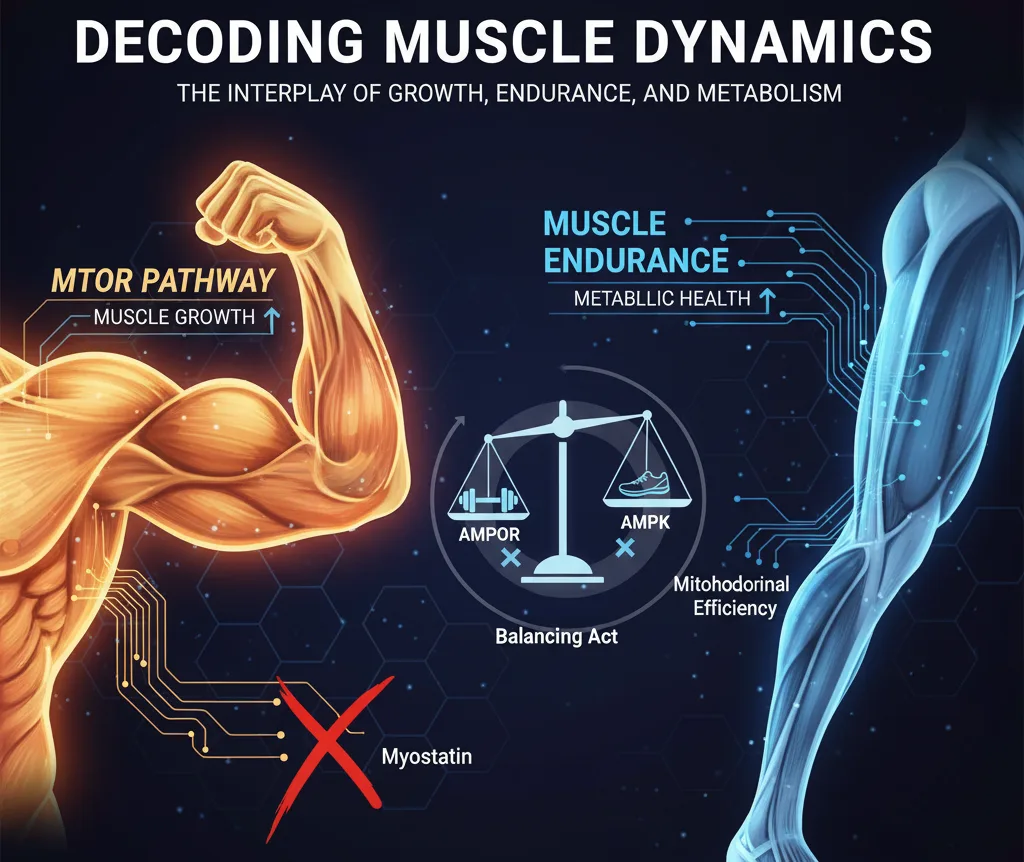The human body is a marvel of intricate systems, and none are more dynamic than our muscles. Whether you're an athlete striving for peak performance or simply interested in optimizing your health, understanding the molecular pathways that govern muscle growth, endurance, and metabolism is key. A recent diagram illustrates this complex interplay, highlighting the roles of key molecules like Myostatin, mTOR, and AMPK.
Myostatin: The Muscle Growth Governor
At the forefront of muscle regulation is Myostatin, a protein produced primarily in skeletal muscle cells. Its primary role is to act as a muscle growth inhibitor. Imagine Myostatin as a natural brake on muscle expansion; it prevents muscles from growing excessively large. This inhibitory action is primarily mediated through its effect on the mTOR (mechanistic Target of Rapamycin) pathway, a critical regulator of protein synthesis and cell growth. When Myostatin is active, it suppresses mTOR, thereby limiting the muscle's ability to synthesize new proteins and, consequently, its capacity for growth.
AMPK: The Metabolic Master Switch
In contrast to Myostatin's growth-inhibiting role, the AMPK (AMP-activated protein kinase) pathway emerges as a central player in energy metabolism and muscle adaptation for endurance. When activated, typically during periods of low cellular energy (e.g., exercise, caloric restriction), AMPK initiates a cascade of beneficial effects:
-
Enhanced Glucose Uptake and Insulin Sensitivity: AMPK activation significantly increases the muscle cells' ability to absorb glucose from the bloodstream, a crucial process for energy production. Simultaneously, it improves insulin sensitivity, making the body more efficient at managing blood sugar levels.
-
Metabolic Stress Reduction: By optimizing energy utilization and promoting efficient fuel burning, AMPK helps to reduce metabolic stress within the cells. This contributes to overall cellular health and can even positively impact the extracellular matrix (ECM), the scaffolding that supports muscle tissue.
-
mTOR Inhibition (and its dual role): Interestingly, AMPK also inhibits the mTOR pathway. While this might seem counterintuitive for muscle development, it highlights a crucial balance. When the body needs to conserve energy and optimize endurance, AMPK temporarily "downregulates" anabolic (growth-promoting) processes to prioritize energy efficiency. This ensures that resources are allocated effectively, preventing excessive muscle growth that might be metabolically costly during periods of high energy demand.
Building Stamina: Muscle Endurance and Fatigue Resistance
The AMPK pathway is instrumental in transforming muscle fibers to enhance endurance. Muscle endurance is defined as the ability to perform sustained work without succumbing to fatigue. AMPK facilitates this by:
-
Oxidative Fiber Transformation: It promotes the shift of muscle fibers towards an "oxidative" type. These fibers are rich in mitochondria and are highly efficient at using oxygen to produce energy (ATP) over long periods, making them ideal for sustained activities.
-
Increased Mitochondrial Efficiency: Mitochondria are the powerhouses of the cell. AMPK boosts their number and efficiency, allowing muscles to generate ATP more effectively from fats and carbohydrates, thereby increasing their capacity for prolonged activity.
This leads directly to fatigue resistance, which is the ability to delay the onset of fatigue. By reducing metabolic stress and ensuring a steady, ample supply of ATP, AMPK helps muscles maintain stable activity for longer durations.
The Balancing Act: Growth vs. Endurance
Ultimately, the diagram and its accompanying text reveal a fundamental biological trade-off: muscle growth versus muscle endurance and metabolic efficiency. While mTOR drives the bulk and strength associated with power-based activities, AMPK fine-tunes the cellular machinery for sustained effort and overall metabolic health.
Understanding these pathways provides invaluable insights for training, nutrition, and even therapeutic interventions aimed at improving muscle function and metabolic well-being. By manipulating factors that influence Myostatin, mTOR, and AMPK, individuals can strategically nudge their musculature towards specific adaptations, whether it's building sheer size or cultivating unwavering stamina.
